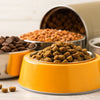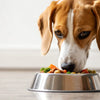How to Get a Picky Dog to Eat Dry Food: A Comprehensive Guide
- Houndsy
Table of Contents
- Introduction
- Understanding Picky Eating in Dogs
- Creating a Feeding Routine
- Optimizing Food Appeal
- Addressing Potential Health Concerns
- Engaging Your Dog During Mealtime
- Conclusion
Introduction
Have you ever watched your dog turn their nose up at a perfectly good bowl of dry food? You’re not alone. Studies indicate that approximately 20% of pet owners report their dogs as being picky eaters. As devoted pet parents, we want our furry friends to thrive, and when they refuse to eat, it can be a source of concern and frustration. Understanding how to get a picky dog to eat dry food is crucial for ensuring they receive the nutrition they need.
In this blog post, we will explore the various reasons why some dogs may be finicky eaters and provide practical strategies to encourage them to enjoy their meals. From understanding underlying health issues to creating a mealtime routine, we’ll cover all aspects of this common challenge. By the end, you’ll have actionable insights to help your picky pup develop a healthier relationship with their food.
As we dive into the world of canine eating habits, we invite you to reflect on your own dog’s feeding routine. Are there patterns that might be influencing their picky behavior? With Houndsy’s mission to simplify and elevate the dog-feeding experience, we’re here to guide you every step of the way.
Understanding Picky Eating in Dogs
Identifying the Problem
Before labeling your dog as a picky eater, it's essential to identify whether their behavior stems from preference or underlying health issues. A sudden change in appetite can often signal an underlying medical condition. Some common factors include:
- Dental Issues: Painful teeth or gums can discourage your dog from eating.
- Gastrointestinal Upset: Conditions such as nausea or intestinal parasites can impact appetite.
- Stress or Anxiety: Changes in environment or routine can lead to reduced interest in food.
If you suspect your dog may have a health issue, consulting with your veterinarian is a vital first step. A thorough examination can help rule out any serious conditions and provide peace of mind.
Behavioral Factors
In many cases, pickiness can be a learned behavior. Dogs quickly learn that if they refuse their food, they might receive treats or human food instead. This behavior reinforcement can create a cycle of pickiness. Here are some behavioral factors to consider:
- Overindulgence: If your dog receives too many treats or table scraps, they may hold out for something more appealing.
- Food Variety: Offering a wide range of food options can lead to indecision and a preference for specific flavors.
- Boredom: Dogs can get tired of the same food day in and day out, leading them to refuse their meals.
Understanding these factors can help us approach the situation with a more informed perspective.
Creating a Feeding Routine
Establishing Meal Times
One effective strategy for encouraging your picky dog to eat dry food is establishing a consistent feeding routine. By offering food at specific times rather than leaving it out all day, you can help create a sense of urgency. Here’s how to implement this:
- Set Regular Feeding Times: Feed your dog at the same times each day. This consistency can help your dog understand when to expect food, making them more likely to eat.
- Limit Exposure: Leave food out for a limited time (about 15-30 minutes) before removing it. This approach emphasizes that food is available for a short period, encouraging them to eat when it's offered.
- Use Portion Control: Measure your dog’s food to ensure they receive the appropriate amount. Overfeeding can lead to a lack of appetite.
Choosing the Right Location
The environment in which your dog eats plays a crucial role in their willingness to eat. Here are some tips to optimize the feeding location:
- Quiet Area: Choose a calm, quiet space free from distractions like loud noises or foot traffic.
- Consistency: Feed your dog in the same spot each time to create familiarity and comfort.
- Comfort: Ensure that your dog’s feeding area is comfortable and accessible, especially for senior dogs or those with mobility issues.
Optimizing Food Appeal
Selecting the Right Food
Not all dry foods are created equal, and some may simply not appeal to your dog. When choosing a food, consider the following:
- Quality of Ingredients: Look for high-quality, nutritious dry food that lists real meat as the first ingredient. Avoid fillers and artificial additives.
- Flavor Variety: If your dog seems bored with their current food, consider switching flavors or brands. Gradually introduce new options to avoid digestive upset.
- Texture Matters: Some dogs prefer specific kibble shapes or sizes. Experimenting with different textures can help find what your dog enjoys.
Enhancing Dry Food with Toppers
If your pup is still hesitant to eat dry food, consider using toppers to make mealtime more enticing. Here are some safe and healthy options:
- Wet Food: Mixing in a small amount of high-quality wet food can enhance the flavor and aroma of their meal.
- Bone Broth: Adding a splash of low-sodium bone broth can make dry kibble more appealing.
- Plain Yogurt: A dollop of plain, unsweetened yogurt can serve as a tasty topper that many dogs love.
Experimenting with Temperature and Preparation
Sometimes, warming your dog’s food can enhance its smell and taste, stimulating their appetite. Here’s how to do it:
- Warm Water: Soaking dry kibble in warm water for a few minutes can make it more palatable.
- Microwave: Gently warming wet food in the microwave (ensure it’s not too hot) can release enticing aromas.
Addressing Potential Health Concerns
Regular Veterinary Check-Ups
Routine veterinary visits are essential for monitoring your dog’s health and catching any underlying issues early. Discuss any changes in your dog’s eating habits with your veterinarian to rule out medical problems.
Monitoring Weight and Nutrition
Keep an eye on your dog’s weight and overall health. An ideal weight is crucial for a healthy appetite. If your dog is overweight, it may be necessary to reassess their diet and portion sizes.
Engaging Your Dog During Mealtime
Interactive Feeding Solutions
Enhancing mealtime engagement can help encourage your dog to eat. Here are some interactive feeding ideas:
- Puzzle Feeders: These toys stimulate your dog’s mind while they eat, making mealtime a fun challenge.
- Snuffle Mats: Hiding kibble in a snuffle mat encourages your dog to forage for their food, tapping into their natural instincts.
Positive Reinforcement and Interaction
Using positive reinforcement techniques can create a more enjoyable mealtime experience. Here are some strategies:
- Praise and Attention: Offer plenty of praise when your dog eats from their bowl. This positive association can encourage them to eat.
- Training Sessions: Incorporate feeding time into training sessions to reward your dog with their food after a successful training exercise.
Conclusion
Addressing picky eating in dogs requires a multi-faceted approach, combining understanding, routine, and creativity. By identifying underlying issues, establishing a feeding routine, optimizing food appeal, and engaging your dog during mealtime, we can foster a healthier relationship with food.
As part of our commitment to enhancing the daily feeding experience, we encourage you to explore our flagship product, the Houndsy Kibble Dispenser. With its mid-century modern design and perfect portion control, it simplifies feeding and keeps mealtime enjoyable.
If you have additional questions or want to discuss your dog’s feeding habits, we’re here to support you on this journey. Together, we can turn your picky pup into a happy, healthy eater.
FAQ
Q: What should I do if my dog refuses to eat for an extended period?
A: If your dog refuses to eat for more than 24 hours, it’s essential to consult your veterinarian to rule out any underlying health issues.
Q: Can I mix wet food with dry food?
A: Yes, adding a small amount of wet food to dry kibble can enhance flavor and make it more appealing to picky eaters.
Q: How can I tell if my dog is overweight?
A: You can check your dog's weight against breed standards and observe their body condition. A vet visit can provide a professional assessment.
Q: What if my dog only eats treats and refuses their regular food?
A: Gradually reduce the number of treats you give and ensure that they are not free-feeding throughout the day. This can help encourage them to eat their regular food.
Q: Is it okay for my dog to skip a meal?
A: Healthy dogs can skip a meal occasionally without concern. However, if they show signs of distress or continue to refuse food, consult your veterinarian.












